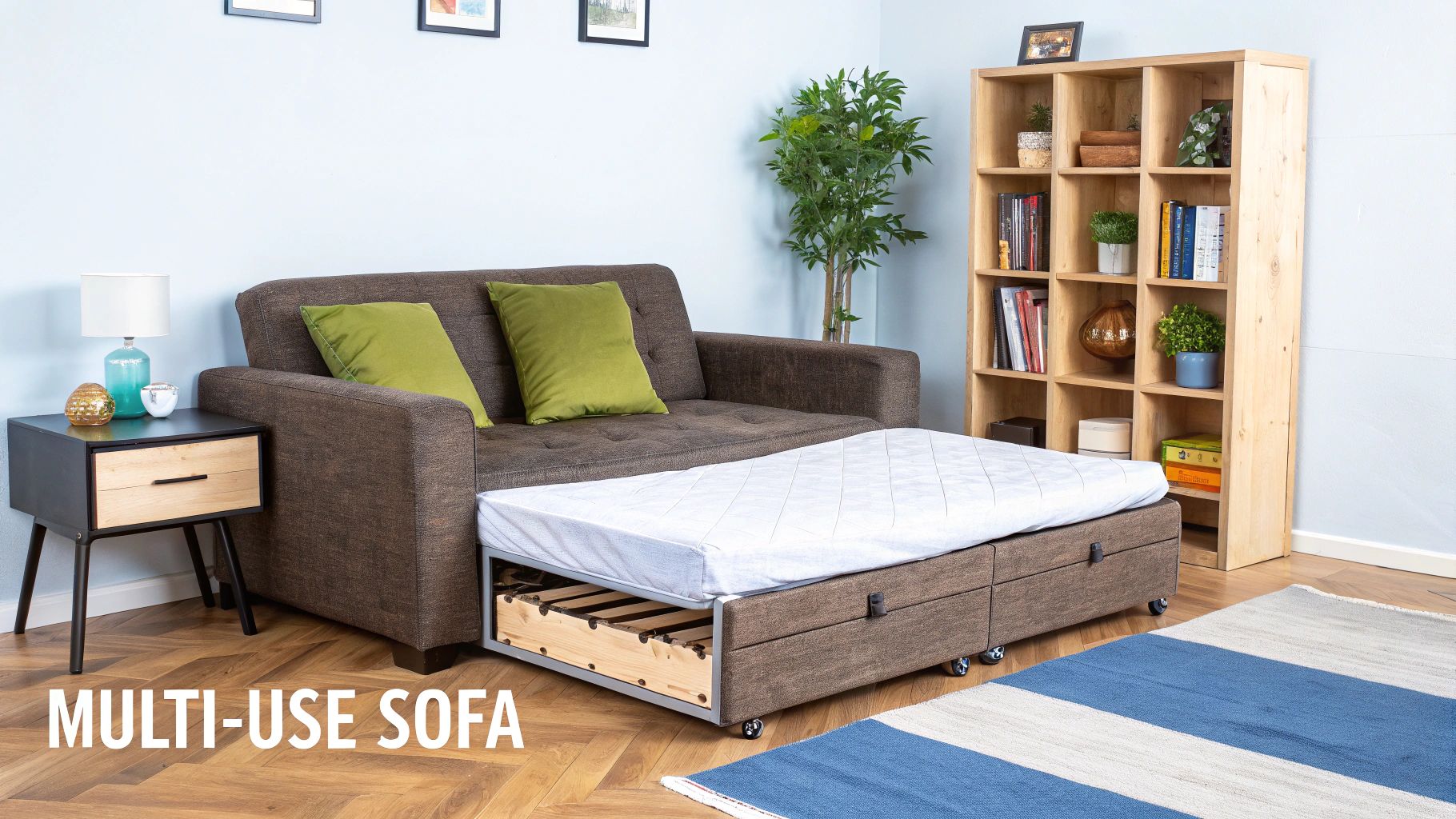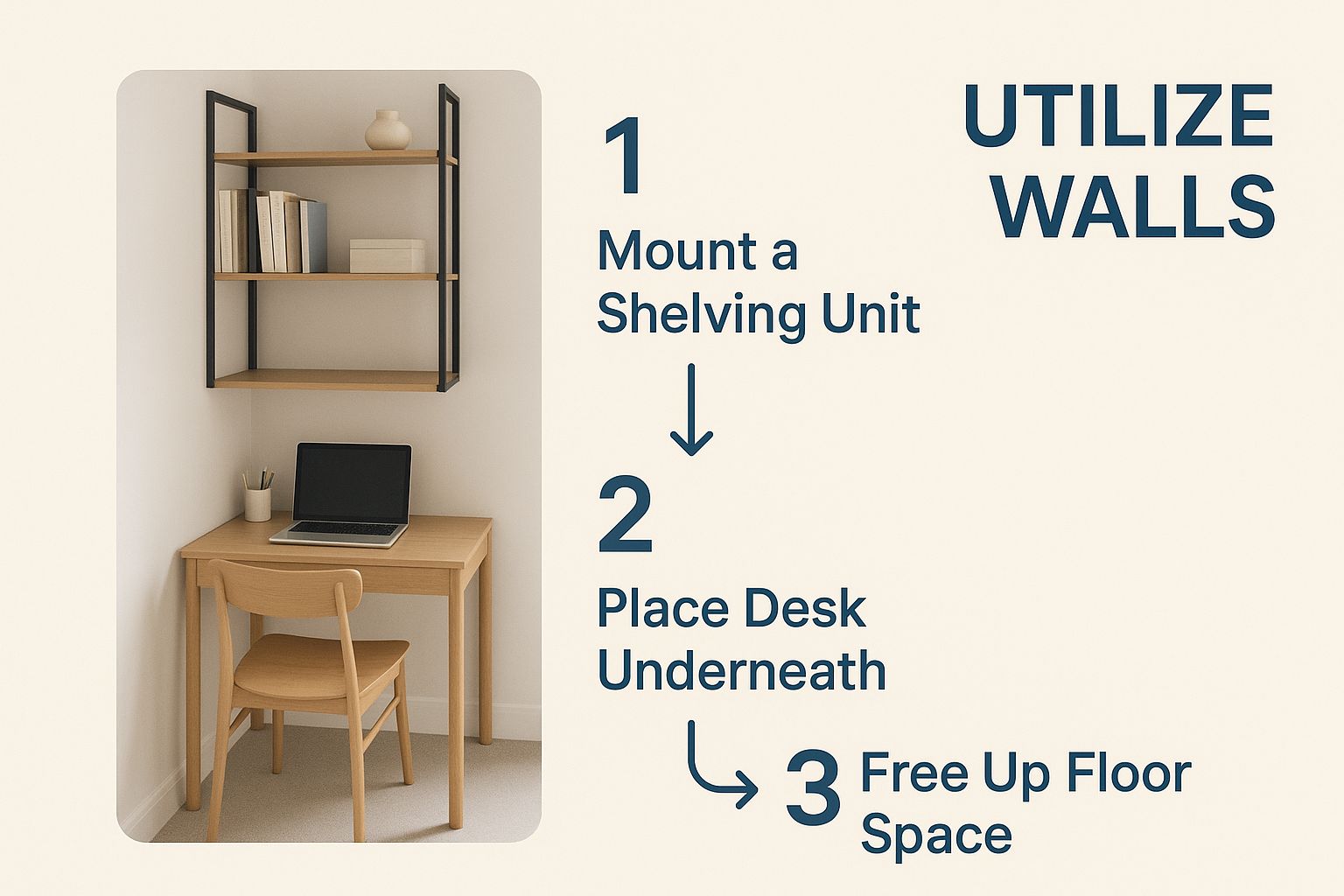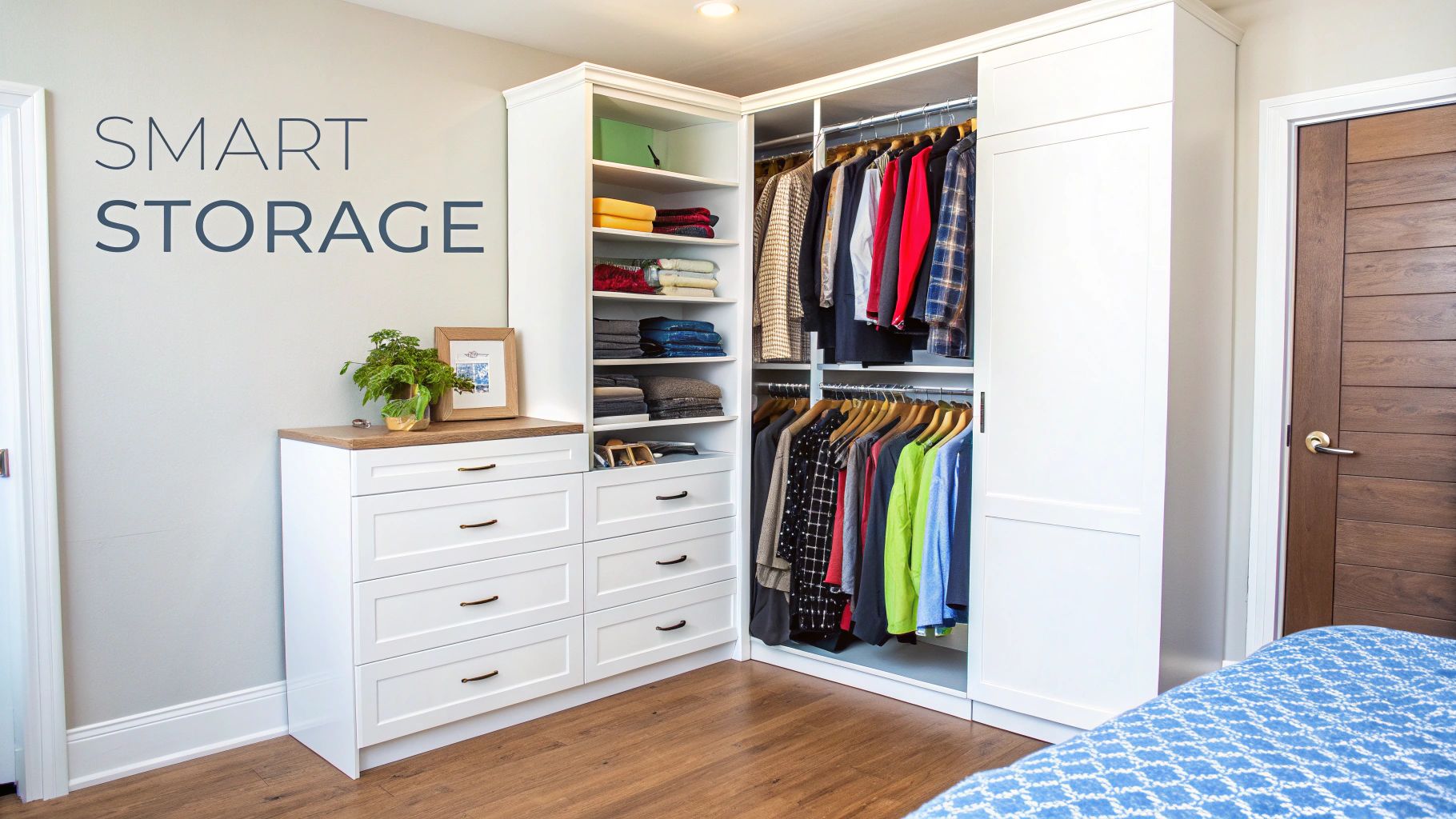Living in a smaller UK home isn't a limitation—it's an invitation to get clever with your design. This guide is all about moving past the challenge of limited square footage and showing you how to pick out furniture for small space living that’s both beautiful and genuinely useful. Let's ditch that cramped feeling and make your home feel thoughtful, intentional, and completely you.
Rethinking Your Space for Smarter Living
Embracing a compact home starts with a mindset shift. Instead of seeing walls that close in, see the potential waiting to be unlocked. The secret is choosing furniture that doesn't just fit the space, but actively makes your life easier by doing more than one job. This isn't about making sacrifices; it's about making smart, deliberate choices that create a feeling of openness and calm.

And it’s a trend that’s catching on. With more of us living in cities and smaller households, the demand for space-savvy solutions has skyrocketed. You can see it reflected in the UK's furniture market, which is valued at around £18.78 billion in 2025 and continues to grow. This boom in compact living is what’s driving the innovation in small-space furniture. If you’re interested, you can dive deeper into the UK furniture market trends to see the full picture.
Why Smart Furniture Choices Matter
Picking the right pieces is about so much more than just preventing clutter. It fundamentally changes the way you live in and feel about your home.
Here’s why taking a thoughtful approach is a game-changer:
- It Maximises Functionality: Every item needs to earn its keep. A storage ottoman isn't just a place to put your feet up; it's a hidden home for throws, remote controls, or magazines.
- It Creates a Sense of Calm: There's a real connection between a tidy, well-organised space and a clearer mind. It just feels better to come home to.
- It Improves Flow and Movement: Furniture that's scaled correctly makes it easy to move around. Your room feels less like an obstacle course and more like an open, inviting space.
The real aim is to make every square foot count. Your furniture should work with you, helping to create a home that feels spacious, organised, and perfectly designed for your day-to-day life, no matter its size.
At the end of the day, furnishing a small space is a creative puzzle. By focusing on multi-purpose pieces, keeping your style consistent, and choosing quality over quantity, you can craft a home that feels both expansive and deeply personal. It's about building a collection of things you truly love and that serve you well.
Measure Twice, Buy Once: A Practical Guide
Before you even think about clicking "add to basket" on that gorgeous sofa, your most crucial task is right there in your own home, armed with a tape measure. Getting a true feel for your room's dimensions is the absolute foundation of successful small-space living. This isn't just about noting the length and width; it's about understanding the space you actually have to work with, quirks and all.
I've seen it countless times: a beautiful plan gets derailed by something as simple as the swing of a door, the depth of a window sill, or a radiator that juts out from the wall. These little obstacles can quickly turn a "perfect fit" into an impossible squeeze.
A great little trick I always recommend is to use painter's tape to mark out the footprint of a potential sofa or table on the floor. This gives you a real-world feel for how much space it will take up and, just as importantly, how much room you'll have to walk around it.
Charting Your Course With a Floor Plan
You don't need to be an architect to create a useful floor plan. Just grab a piece of paper and sketch out the basic shape of the room. Jot down all the key measurements, paying close attention to the distance between windows and the exact location of plug sockets and light switches. This simple sketch becomes your indispensable shopping companion, turning guesswork into informed, intentional decisions.
Don't forget to measure the ceiling height! It’s a detail that’s easily overlooked but absolutely vital if you're thinking about tall bookcases or vertical shelving to maximise your storage.
By mapping out your space first, you shift from being a hopeful browser into a confident, prepared shopper. You'll know the exact dimensions you're looking for, saving yourself from the inevitable disappointment of a piece that just won't work.
Mastering the Art of Measurement
When you’re working with a compact room, precision is everything. A single centimetre can be the difference between a satisfyingly snug fit and a frustrating trip back to the returns department.
Before you finalise any purchase, it’s worth running through a quick checklist of measurements. I’ve put together a table of the essentials that will help you think through every angle.
Essential Measurements for Small Space Furniture
| Area to Measure | Why It's Important | Pro Tip |
|---|---|---|
| Room Dimensions | The basic length, width, and height set the stage for your entire layout. | Measure at multiple points. Walls are rarely perfectly straight! |
| Doorways & Hallways | Your dream sofa is useless if you can't get it through the front door or up the stairs. | Don't forget to measure diagonal clearance for tilting larger items. |
| Permanent Fixtures | Radiators, fireplaces, and built-in units are immovable objects you must work around. | Measure how far they protrude from the wall, not just their surface area. |
| Window & Sill Height | This affects the placement of everything from desks to sofas and sideboards. | Make sure you can still open your windows fully with furniture in place. |
| Circulation Space | The clear paths you need to walk through the room without bumping into things. | Aim for at least 75cm of clear walkway in main traffic areas. |
This process might seem a bit tedious, but taking 15-20 minutes to get these numbers right will save you hours of hassle—and potentially hundreds of pounds—down the line.

As this image shows, using your walls is a core principle of small-space design. Clever vertical storage, like shelving above a desk, reclaims precious floor space and adds function without creating clutter.
Of course, for big-ticket items like a couch, getting the measurements right is non-negotiable. For a detailed walkthrough on that, you might find our guide on how to measure a sofa really helpful to ensure a perfect fit every time.
Choosing Smart Multifunctional Furniture
This is where the real magic of furnishing a small space happens. Multifunctional pieces are the heroes of compact UK homes, blending sophisticated style with brilliant utility. It’s time to think beyond the standard sofa bed and explore furniture that works harder, smarter, and more elegantly for you.
When you invest in these clever items, every piece has to earn its place. Many will serve two or even three functions without gobbling up any extra floor space. This approach is absolutely key to creating a home that feels both organised and surprisingly spacious.

It’s no surprise that the demand for this kind of intelligent design is growing. The multifunctional furniture market in the UK is projected to grow by over 4% annually between 2025 and 2033. This trend just goes to show how vital dual-purpose furniture has become for modern living, especially in flats and shared homes.
Go Beyond the Obvious Choices
When people hear "multifunctional furniture," the sofa bed is usually the first thing that springs to mind. And while they're incredibly useful, the world of smart furniture extends so much further. Let's look at some practical examples that solve common small-space dilemmas.
- The Storage Ottoman Bed: This is a true game-changer for a studio flat or spare room. By day, it’s a stylish footrest or extra seat. By night, it unfolds into a comfortable bed, with the added bonus of deep internal storage for bedding or just hiding clutter.
- Extendable Dining Tables: Perfect for anyone who loves to host but doesn't have a dedicated dining room. A compact console table can sit neatly against a wall as a handy surface, then pull out to seat six or more for a dinner party. Genius.
- Nesting Coffee Tables: Instead of one large, bulky coffee table, a set of two or three nesting tables offers brilliant flexibility. You can spread them out when guests are over, then tuck them neatly away to reclaim your floor space afterwards.
Your goal should be to find beautifully designed pieces that you love, which also happen to be incredibly practical. Don't compromise on quality; one well-made convertible item will serve you far better and longer than several single-purpose, lower-quality ones.
Maximising Every Nook and Cranny
Beyond the living room, clever furniture can transform every corner of your home. A wall-mounted desk, for instance, can be folded away when your workday is done, instantly turning your home office back into a living area. This simple act reclaims valuable floor space and helps create a much-needed separation between work and home life.
Modular shelving is another fantastic investment. You can start with a small unit and add more sections as your needs or book collection grows. This adaptability ensures your storage evolves with you, so you aren't forced to buy entirely new furniture down the line.
Even the humble sofa bed has evolved significantly. Modern designs often include brilliant features like a chaise longue with hidden storage, adding another layer of functionality. If you're looking for the perfect fit, you might want to explore our guide on sofa beds with a chaise longue for more ideas.
Creating the Illusion of More Space
Picking out clever, multi-functional furniture for a small space is a massive win, but how you actually arrange everything is just as crucial. A few simple interior design tricks can completely transform a cramped room, making it feel so much larger and brighter than the tape measure would have you believe. It’s all about tricking the eye and creating a real sense of openness.
One of the most effective tricks I've seen is choosing ‘leggy’ furniture. A sofa, sideboard, or armchair raised up on visible legs instantly makes a room feel more spacious. Because you can see the floor underneath, the furniture seems to almost float, which massively reduces its visual weight and stops the room from feeling cluttered.
Let There Be Light and Reflection
Making the most of light, both natural and artificial, is absolutely fundamental to making a room feel bigger. This is where mirrors become your best friend. A large mirror placed opposite a window will bounce light all around the room, creating an immediate sense of depth and brightness. It literally doubles the visual space in that direction.
But don't just think of mirrors as a practical tool; use them as a decorative centrepiece. A beautifully framed mirror can easily double as a piece of art while it's working its space-enhancing magic.
The goal isn't just to fill a room, but to curate it. Strategic placement of reflective surfaces and a light colour palette for your largest pieces, like your sofa, can make even the most compact room feel airy and welcoming.
On that note, think about other reflective surfaces too. A glass coffee table or a lacquered sideboard has a similar light-bouncing effect without adding any visual bulk. These pieces often seem to blend into the background, keeping your line of sight clear and uncluttered. You can find more simple but effective tricks in our guide to living room makeover ideas.
Drawing the Eye Upwards
Here’s another powerful technique: use your vertical space. When your floor space is at a premium, you need to encourage the eye to travel upwards. This little illusion gives the impression of higher ceilings and a far more expansive room.
Here are a few ways I like to do this:
- Tall, Narrow Bookcases: A slim, tall bookcase naturally draws your gaze up and gives you excellent storage without taking up a huge amount of floor space.
- Vertical Stripes: Think about using wallpaper with a subtle vertical stripe on an accent wall. It’s a classic for a reason – it really does create a sense of height.
- High-Mounted Curtains: This is a game-changer. Hang your curtain rod higher and wider than the actual window frame. Letting the curtains hang all the way to the floor makes the windows seem so much larger.
When you start combining these strategies—elevating your furniture, playing with light, and thinking vertically—you can dramatically change how your space feels. These simple tweaks all work together to create a home that feels open, organised, and far more spacious than you might have thought possible.
Mastering Storage for a Clutter-Free Home
In any compact home, clutter is the ultimate enemy. It doesn't just eat up physical space; it adds visual weight, making a room feel instantly smaller and more chaotic. The key to winning this battle is integrating clever storage that feels like a natural part of your decor, not a bulky afterthought.
This means looking beyond the obvious floor-level solutions. Your walls, for example, offer a huge amount of untapped potential. Thinking vertically is one of the core principles I always come back to when choosing furniture for small space living.
Utilise Overlooked Vertical Real Estate
So often, the most valuable storage areas are the ones we completely ignore. That patch of wall above a doorway? It’s the perfect spot for a high shelf to store things you don't need every day, like seasonal decorations or spare bedding. By drawing the eye upward, you also create an illusion of height, which makes the whole room feel more expansive.
Wall-mounted cabinetry is another fantastic option. You get ample storage without consuming a single inch of precious floor space, which keeps the area feeling open and easy to move through.
The most effective storage solutions are those that blend in seamlessly. Your aim is to find pieces that are both beautiful and functional, adding to your home's style while secretly keeping everything organised and out of sight.
This strategic approach to furniture isn't just a niche trend. Market dynamics in the UK show a strong link between urban housing trends and the demand for compact furniture solutions. As our cities grow and single-person households increase, so does the need for smart, space-efficient designs. For a deeper dive into this, you can explore some global small space furniture market insights.
Furniture with Hidden Depths
Some of the most powerful storage tools hide in plain sight. Furniture designed with built-in, hidden compartments is your secret weapon for maintaining a tidy, calm environment. It's all about finding pieces that pull double duty, combining seating or surface area with concealed storage.
I've seen these work wonders in many homes:
- A hallway bench with a lift-up seat: This gives you a place to sit while putting on shoes and simultaneously hides away scarves, hats, and other outdoor bits and bobs.
- An ottoman with a removable lid: Perfect for stashing remote controls, magazines, or extra throws right where you need them in the living room.
- A bed frame with built-in drawers: This one's a classic for a reason. It offers an enormous amount of storage for clothes or linens without needing any extra furniture.
Once you have these hero pieces, the next step is to organise their interiors. Don’t just throw things in! Use drawer dividers, small baskets, and vacuum-sealed bags to categorise items and make sure every bit of space is used effectively. This internal organisation is just as important as the furniture itself for keeping clutter permanently at bay.
Your Small Space Furniture Questions Answered
Even when you think you’ve got a handle on your small space, there are always a few nagging questions that pop up. Choosing furniture for a snug living room or a tiny studio flat can feel like a high-stakes puzzle, and it's easy to get stuck.
Think of this section as your personal trouble-shooter. I've gathered some of the most common queries I hear and broken them down with simple, practical advice to help you get unstuck and feel confident in your choices.
What’s the Best Type of Sofa for a Very Small Living Room?
In a really tight living room, your best bet is almost always a two-seater sofa, sometimes called a ‘loveseat’. Going for this smaller size prevents the single largest piece of furniture from completely dominating the room.
The trick is to look for models with a slim profile. That means slender arms and, crucially, raised legs. Seeing the floor underneath the sofa creates an illusion of more space and makes the whole room feel lighter and more open. It’s a small detail that makes a world of difference.
A modular sofa can also be a brilliant, flexible friend. You can simply pick out two or three sections to build a sofa that’s a perfect fit for your specific layout. And if you need to host the odd overnight guest, a compact sofa bed with a simple, no-fuss mechanism is a fantastic multi-tasker.
A quick tip from experience: no matter what style you go for, try to pick a light, neutral colour. Shades like soft grey, cream, or beige just don't feel as bulky. They reflect light beautifully and help the sofa blend in, rather than stick out.
How Can I Squeeze a Dining Area into My Studio Flat?
This is where you need to get a little creative. Carving out a dining spot in a studio is all about finding furniture that works harder. A drop-leaf or gateleg table is a classic for a reason—it’s a master of disguise. You can keep it folded down against a wall for everyday meals for one or two, then simply flip up the leaves when friends come over.
Another great option is a high, slender bar table with a couple of matching stools. This creates a really clear ‘dining zone’ without eating up precious floor space.
Here are a few other clever ideas I’ve seen work wonders:
- A Round Pedestal Table: With no chunky legs at the corners, this style has a much smaller visual and physical footprint. You can tuck chairs right under, keeping everything neat.
- Wall-Mounted Fold-Down Table: If you are seriously short on space, this is a game-changer. When you’re done eating, it folds flat against the wall and completely disappears, giving you your floor back.
Is Dark Furniture a Complete No-Go in a Small Room?
Absolutely not! While it’s true that lighter colours are your safest bet for making a room feel bigger, you can definitely bring in darker pieces. It’s all about balance.
If your heart is set on a gorgeous dark navy sofa or a dramatic charcoal bookshelf, just make sure the elements around it are light and bright to compensate. Pair that statement piece with crisp white walls, a pale-coloured rug to anchor the furniture, and sheer curtains to let in as much natural daylight as possible.
Think of it this way: a single, bold, dark piece can act as a sophisticated focal point, adding depth and a bit of drama. The mistake people make is filling the entire room with dark, heavy furniture. That’s what makes a space feel closed-in and cramped. The key is to create contrast.
Ready to give your sofa a fresh look without the cost and hassle of buying a new one? At The Sofa Cover Crafter, we craft beautiful, practical, and washable sofa covers designed right here for UK homes. Protect your furniture and completely change the feel of your living space. Explore our collections at The Sofa Cover Crafter and find your perfect fit today.



